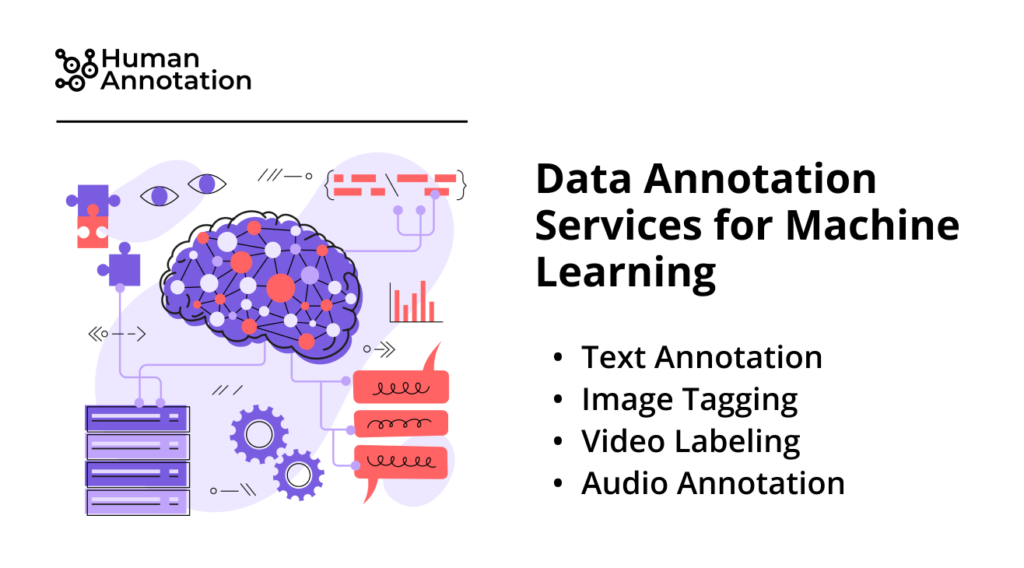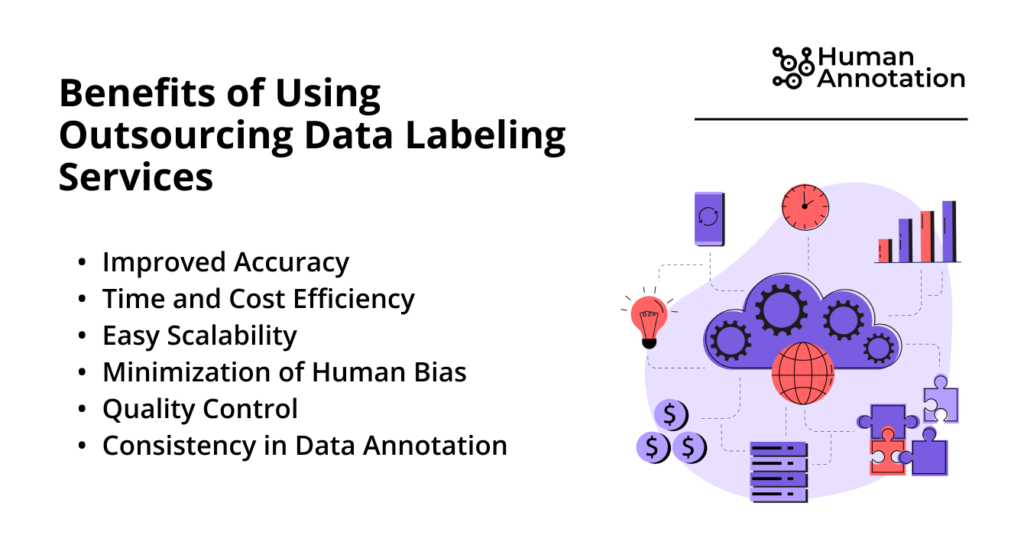
- The Role of Accurate Data Annotation for Machine Learning Models
- Types of Data Annotation Services for Machine Learning Projects
- How Can Professional Data Annotation Reduce Cost and Time Spent on Your AI Project?
- Additional Benefits of High-Quality Data Labeling Machine Learning Services
- How to Outsource Machine Learning Data Annotation Services for Your Business
When we see the number of AI-driven tools grow each month, Artificial Intelligence seems to stay with us forever. And since accurate data labeling is the critical success factor for training Machine Learning (ML) models, data annotation machine learning services are in demand. Moreover, by hiring top-notch data annotators and using advanced software, project owners can save time and money.
The Role of Accurate Data Annotation for Machine Learning Models
Training datasets teach machines to see, hear and read like humans. We expect AI-based software and devices to help us perform various tasks equally well: from locking the house door to identifying potential tumors. But humans empower computers, so we shouldn’t underestimate our input into creating Artificial Intelligence.
Image and video labelers identify vehicles and road markings for self-driving cars. Text labelers tag keywords and intent, helping chatbots respond to users. Audio annotators make it possible to switch on TVs with voice commands. But let’s check what these specialists can do.
Types of Data Annotation Services for Machine Learning Projects

Below are the four basic types of labeling data Machine Learning models can require:
Text Annotation
Labeling specific elements in the text and converting image-like documents to text empowers hundreds of software products around us. For instance:
- Named-entity recognition lets companies find web resources that mention their brand, products, CEO, or other relevant information.
- Sentiment analysis allows us to analyze reviews and comments and identify if they’re negative, positive, or neutral. This way, brands can respond to customers’ feedback.
- Intent analysis classifies the content that mentions your keyword, like complaint, appreciation, spam, etc. This gives a different understanding of how to react to such content.
- Phrase chunking is the natural language annotation for Machine Learning that helps digitize and structure hundreds of documents. Legal advisors, doctors, insurers, and other professionals leverage this technology.
Image Tagging
Self-driving, security, agriculture, manufacturing, healthcare, and others use AI-powered tools trained by image annotators. These are the fundamental techniques applied:
- 2D and 3D bounding boxes frame flat and volumetric objects, helping machines identify similar ones.
- Polygon annotation is the more accurate way of marking cars, people, buildings, etc., as specialists mark only relevant pixels.
- Semantic segmentation allows tagging each piece of the image and classifying every pixel on an image.
- Landmark and keypoint annotation techniques help identify facial expressions and detect the movements of humans and animals.
- Line and polyline labeling teaches computer vision algorithms to “read” road and floor markings.
- Image classification. This approach helps categorize the entire picture like a separate class.
Video Labeling
Video annotation is needed to enable real-time analysis of video streams from security cameras and aerial videos. Data labelers use the same approaches to tagging videos, which they apply for image annotation. That’s because videos are split into multiple frames — images and processed with:
- 2D bounding boxes
- Cuboids (3D boxes)
- Landmark & keypoint annotation
- Polygon annotation
- Semantic labeling
- Lines and splines annotation
- Video classification.
Audio Annotation
IoT, e-commerce, healthcare, banking, and customer service are only a few industries that leverage speech recognition technology. Voice-powered software helps us set the in-house temperature, digitize clinical statements, search items in browsers, do real-time translations, and confirm identity.
The audio annotation services you can get are:
- Sound labeling helps to distinguish voices, sounds made by animals, birds, nature, and mechanisms.
- Music classification lets algorithms classify music genres and moods compositions evoke.
- Speech-to-text transcription transforms voice to text regardless of language and audio file type.
- Environmental and acoustic sound classification allows ML models to differentiate the sounds of devices, vehicles, parks, rain, etc.
Need Professional Data Annotation Services? Let’s Discuss Your Project!
How Can Professional Data Annotation Reduce Cost and Time Spent on Your AI Project?
Before AI tools go live, project owners have to feed them gigabytes of accurately labeled images, texts, video, and audio files. And if high-level data annotation services cost more, how will hiring top professionals help you cut the cost and duration of your ML project? This will be possible due to the following factors:
- Relevant annotation tools. The instrument should be aimed at your annotation task and support AI assisted labeling. For instance, a data annotator needs to place the bounding box on the first video frame, and the tool will mark the following frames. The labeler will only need to adjust the boxes where necessary. This way, project owners can hire fewer specialists and complete tasks faster.
- Experienced data labelers. Skilled annotators will perform tasks more accurately, so they’ll spend minimum time checking quality and correcting errors. Moreover, they’ll label data faster. But when hiring data taggers who lack experience, you’ll have to spend weeks training them. So though payrolls of top annotators are higher, you’ll save time on processing raw data.
- Raw datasets of better quality. Professionals will pre-process your raw data to eliminate redundancy and noise and ensure heterogeneity or the identical file format of the entire stack. Some datasets may require instance reduction (deleting files) or, vice versa, adding the missing ones. And only labelers with expertise can handle these tasks and cut expenses on raw data.
Additional Benefits of High-Quality Data Labeling Machine Learning Services

In Machine Learning annotation experts won’t only let you cut costs and time spent on your project. Below are several more advantages of hiring a qualified data labeling team from a reliable outsourcing partner:
- Minimization of human bias. The bias error means that certain elements in raw or processed data prevail or miss. With professionals on board, you’ll minimize the exclusion bias (deleting valuable data as irrelevant). Experts will timely identify association bias — when, for instance, in raw datasets, pictures of women or Asian men prevail. Skilled annotators are also free from observer bias — subjective labeling patterns.
- Consistency in data annotation. Experienced annotators know that ensuring consistency in classifying objects, elements, or events is critical. And they know this issue should be addressed at the beginning of the project. They must agree on interpretation criteria and communicate each doubtful file with teammates during the annotation process. This way, they can ensure label consistency.
- Regular QA. No one can avoid the human factor, so even top data labelers can make mistakes. But it’s critical to run QA tests to prevent errors from getting to the final dataset. However, skilled teams spend less time on QA because they minimize ambiguity with instructions and ground truth samples. Some tools allow real-time data validation, which helps eliminate errors.
How to Outsource Machine Learning Data Annotation Services for Your Business
Once you decide to outsource data annotation services for ML project you run, you’ll need to take these three steps:
1. Choose a Reliable Service Provider
With access to websites, LinkedIn accounts, industry ratings, and other relevant resources, you can explore all the details about your potential outsourcing partner. And below are some critical points to consider:
- Recruiting approaches this company uses. You need to find out how your potential partner will build your team. For instance, which channels they use for posting jobs, how they run interviews, and how many recruiters will be engaged.
- Reviews. You can check customers’ feedback about the company on its social media accounts. Also, explore testimonials or case study sections on their websites and niche-relevant online rating resources.
- Cooperation terms. Does this provider offer an option that suits your budget and deadlines? How flexible are they in scaling up? Do they require an advance payment? These answers will impact your choice.
2. Discuss Your Project Requirements
Whether you need natural language annotation for Machine Learning models or plan to annotate videos to train your security camera algorithms, these are the key questions you’ll need to answer:
- How many people do you need? If you can estimate how many labelers will handle your annotation tasks, that’s a good start. However, if you’re unsure, our specialists, for example, can advise on your future team composition.
- When do you need to have your team assembled? Building a team of three or ten people may require different terms. The terms can also depend on the current demand for data labeling specialists. So you’ll need to discuss how realistic your deadlines are.
- What is your budget? The critical point for any project is its budget. And as a project owner, you’ll need to find a cost-effective solution. However, a client-oriented outsourcing partner will always be able to recommend you a beneficial option.
3. Set Tasks for Your Data Annotation Team
Most outsourcing providers start searching for your candidates after you agree on costs and terms. We, for instance, will ask you to sign the NDA at this stage, but it won’t require a prepayment. Our recruiters will send you the CVs of the applicants and engage you in interviews.
As you confirm the final list of your future team members, we will issue the invoice. Once paid, we get employment contracts signed. Now your team is ready to work, so you can share project details, communicate the requirements, and finally assign tasks to them.


